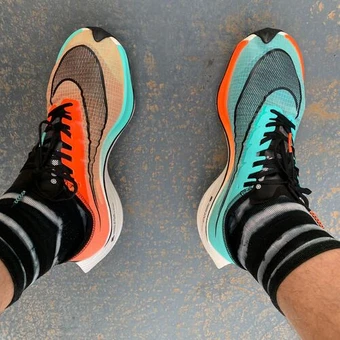At the Olympic Games of Ancient Greece, athletes in the standing jump event (a likely early predecessor to what we now know as the long jump) realised they could gain more distance by holding a weight in each hand (known as ‘Halteres’). The race for performance enhancing aids had officially begun.
Since those early days, we've seen numerous sports chase technological advantages. Even running, with its relative lack of complexity, hasn’t been immune to performance-enhancing developments, although it was arguably a little slow to join the party.
For decades, running’s technological ‘arms race’ had involved little more than wearing the skimpiest clothing, whilst the biggest innovations involved stopwatches, better track surfaces and training methods.
There had been flirtations with alternative approaches, such as barefoot running (Lierberman, 2012), but the running shoe design hadn't made a great deal of progress since rubber had been incorporated into the sole. The main design emphasis had been on racing in the most minimalist shoes, which were as light as possible and supported the runner’s particular gait or running style.
That was until 2016...
The rise of carbon fibre shoes
It was at this time that Nike brought the ‘Vaporfly’ shoe to market and distance running records quickly started to tumble. So, what’s so special about these kinds of shoes? And why has their impact been so great in distance running and triathlon?
Nike's goal was to develop a shoe that would maximise energy return, reduce fatigue, and ultimately improve running economy. These shoes got widespread exposure during Eliud Kipchoge's first sub-two-hour marathon distance attempt in 2017, where he fell short of breaking the two-hour barrier by just 26 seconds. Given that the world record at the time was minutes, not seconds away, this margin of performance enhancement was frankly massive.

Peer-reviewed research demonstrated a potential improvement in a runner's velocity at marathon world record pace of around 2.6-3.4% (Dyer, 2020). In marathon terms, anyone not using such footwear could literally be running in a different zip code to the leader – I kid you not.
One of the first iterations of the novel design concept was the Nike ‘Zoom Vaporfly 4%’. The ‘4%’ in the shoe's name referred to the claim by Nike that it could improve running economy by up to 4%. This was achieved through several key design features.
The most notable innovation saw the inclusion of a carbon fibre plate embedded within the midsole. This plate provided enhanced stability and energy return, allowed runners to suffer less mechanical efficiency losses and helped maintain a more efficient stride. This carbon fibre ‘spring’ is not alone and is typically complemented with a novel foam such as ‘Pebax’. Pebax is merely a tradename for ‘polyether block amide’ (if you want to impress your friends).
Technically speaking, a runner's metabolic saving was mainly due to superior rates of energy being stored in the shoe's midsole foam, a lever effect being created from the carbon-fibre plate, and a stiffening effect of this plate on the foot’s metatarsophalangeal joint in the forefoot.
In essence, it handles your energy from the point your foot strikes the ground, transmits the energy through the shoe, and then returns it as the shoe leaves the surface.
Whilst many people have gone out and bought these shoes, there are a few reasons why they might not work as well for you as they do for the elites.
For example, what many people don’t know is that the stiffness of the carbon fibre spring itself needs to be optimised to match the bodyweight and running cadence of the athlete using them. A heavier runner is going to get a different level of response to a lighter one.
I’d actually seen something similar to this back in 2008 when controversy erupted around double lower-limb amputee Oscar Pistorius’s attempt to qualify for the Olympic Games using carbon fibre ‘Cheetah’ prosthetic limbs. A lot of my research at the time investigated this case and I discovered that the very best Paralympians would need different prosthetic limbs with different stiffness levels based on the event’s length, their ability, and even the phase within the race that would provide the greatest gains.

Without that optimisation, the compression of the spring and its return efficiency would often be slightly ‘out of phase’ with the runner. That’s a bit like bouncing on a trampoline so that you almost bounce in sync with the rebound to progressively increase your height. It’s also why a child can run across a bouncy castle but when a heavier adult tries the same, they resemble a drunken rhino.
Should you use ‘super shoes’?
Some may claim then that the shoes are basically cheating by providing athletes with extra bounce, but this isn’t true. It’s merely a passive form of energy return - the shoes can only give you back what you put into them. The novelty of such shoes is that they're suffering from fewer inefficiencies than traditional running shoes as each step is taken.
In 2018, runners wearing the Nike Vaporfly 4% shoe broke world records in the 100km, marathon, half marathon and 15km running distances, with technology rather than physiology being cited as the main driver of improvements (Muniz-Pardos et al. 2021).
By 2019, the ‘arms race’ was really on as more brands invested in shoe development and Nike further refined their design with the ‘Vaporfly Next%’. This updated version incorporated several refinements.
The most significant change was an even larger carbon fibre plate that extended from the shoes midfoot to the toe, providing additional propulsion during toe-off. The other aspect is that science has shown that a lighter shoe is ultimately a faster shoe (Fuller, 2015), so efforts were made to reduce the running shoe’s mass back down.
Later that year, Brigid Kosgei destroyed the women's marathon world record by 81 seconds and Eliud Kipchoge finally broke the two-hour barrier for the marathon distance at the INEOS 1:59 Challenge. By this point, the sport was getting worried, so the governing body investigated. I was also researching the topic at the time.
Long story short, I felt that the level of performance enhancement wasn’t exactly outrageous compared to other points in the sport's history, but it was clear that the technology was the biggest legal performance enhancement that running had seen in decades.
Critics argued that the shoe's design provided an unfair advantage, therefore leading to an uneven playing field. In my view, the level playing field never existed but even I had to admit it had tilted towards something more akin to a skydive.

It was even reported that elite runners and triathletes were breaking sponsorship contracts because the brand that was supporting them didn’t have the technology in place to keep up with those that did.
As researchers and athletes picked a side in the fight, World Athletics then acted by implementing new regulations for shoe technology. The updated rules limited the stack height of the midsole and banned shoes with more than a single rigid carbon fibre plate. This made sense because shoes were getting taller and these rules limited the space for the designers to work with to improve the shoes' performance further.
In response, brands introduced legal versions of the technology that complied with the new regulations, but records and personal bests have still continued to fall. The time savings and improvements will bottom out at some point – such things always do.
However, we’re at the beginning of the footwear arms race, not at its end. If you’re going to compete, such technology is definitely worth your consideration.
